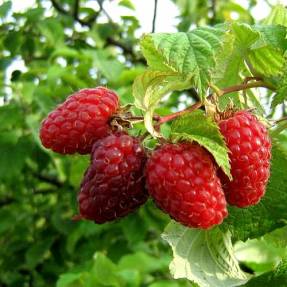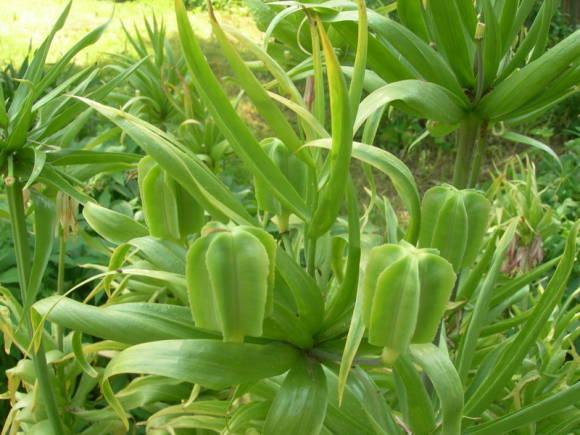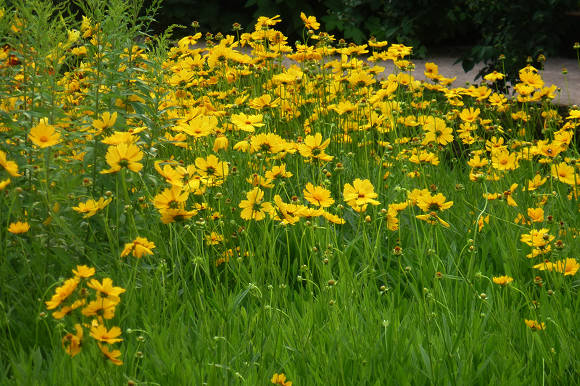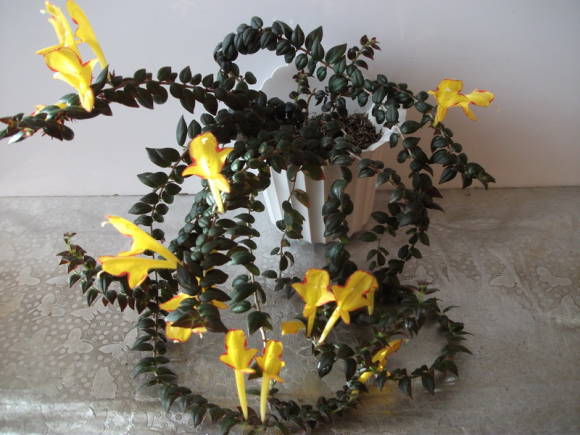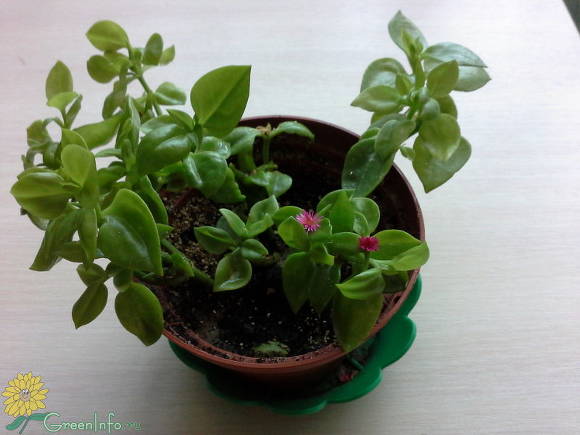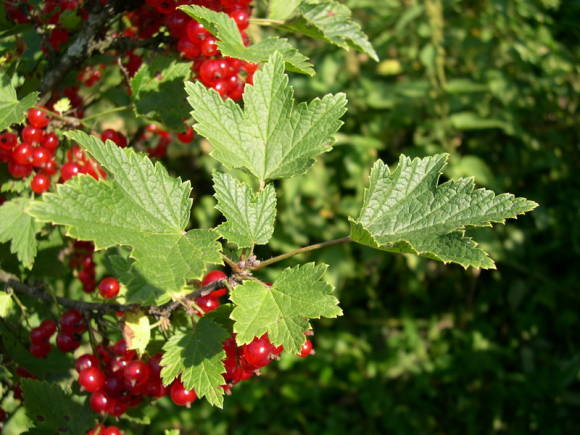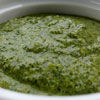 Cardamom leaves Cardamom leaves |
Cardamom (Elettaria cardamomum (L.) Maton) is a perennial herb from the Ginger family (Zingiberaceae) with powerful fleshy rhizomes and erect stems, 2-3 m high. Linear-lanceolate leaves up to 70 cm in length and 8 cm in width. Corolla with three yellow butterfly-like petals. The fruit is a three-celled capsule, which differs in size, shape and color depending on the variety and variety. The seeds are black, fragrant, ribbed.
Cultural history: The name of the spice in almost all European languages sounds like cardamom or something close. In ancient Greece, cardamom was known as an expensive imported commodity and bore the name [καρδάμωμον].
In Roman times, it was referred to under two names: amomum and cardamomum, which is probably due to the fact that other species similar in aroma were imported under the guise of this spice. Entitled cardamomum bought expensive varieties, what we currently refer to as real cardamom, but under the name amomum cheaper javanese black cardamom.
In Ayurvedic medicine, the fruit of cardamom was used 3000 years ago to facilitate breathing, stimulate blood circulation, improve memory, support adrenal function and, like almost all spices, as an aphrodisiac. It has also been used in Chinese medicine for thousands of years. Chinese medicine believes that it can be used to treat intestinal disorders, respiratory diseases, diseases of the genitourinary system. The ancient Egyptians used cardamom in religious ceremonies and for the manufacture of incense, and the ancient Romans and Greeks in perfumery (Davis P., 2008). Dioscorides in the 1st century AD mentioned it in his fundamental work "Materia medica" as a medicinal plant for coughs, abdominal pain. Its seeds were infused with wine and were thus used for epilepsy, spasms, heart disease and as a diuretic. It is believed that cardamom came to medieval Europe with the Arabs.
Cardamom propagates in culture mainly vegetatively - by pieces of rhizomes... But in principle, seed reproduction is also possible. A successful crop requires fertile soils and a tropical, humid climate. Optimal placement of plantations at an altitude of 750-1500 m above sea level. Fruiting begins 2 years after planting. Given that the plant blooms year-round, the crop can also theoretically be harvested from January to December. However, the most intense flowering is observed from January to May, and accordingly the main crop ripens from October to December. The boxes do not ripen at the same time, so they are harvested as they ripen. You need to collect the boxes before they are fully ripe, so that the seeds do not spill out - the most valuable part of the raw material. Until the 7th year of life, the yield of the plantation grows, and after that it begins to fall sharply and, accordingly, new plantings need to be laid. Therefore, as a rule, cardamom is grown in a 7-year culture.
Young plants in a greenhouse |
Preferably light soil by mechanical composition with a sufficient amount of organic matter and with neutral acidity.
Cardamom is propagated in culture vegetatively by a piece of rhizomes with two to three renewal buds... You should not transplant plants with a powerful shoot, they do not take root very well - the leaves evaporate a lot of moisture, and the roots are not working well yet. Care includes timely watering, and in cold weather they are reduced, top dressing with complex fertilizers from March to October. In winter, excess fertilizer, especially nitrogen, worsens the condition of plants... But the daily spraying of the leaves with water and once every 10-15 days with solutions of Ferovit and Zircon increases the resistance of plants to dry indoor air during the winter heating season.
It is not worth counting on flowering and fruiting in indoor conditions. But the leaves also contain essential oil and have a characteristic scent. So it is quite possible to put them in tea or coffee instead of boxes.
Raw materials: In ground form, cardamom is poorly stored and loses about 40% of essential oil in a year. Therefore, it is the fruits that are best bought and stored. And grind them just before use. Greenish fruits are more expensive than pale green or white-yellow fruits that have been dried in the sun.
Other types and falsifications: There are many members of the Ginger family, primarily in childbirth. Amomum, Aframomum and Alpiniawhose seeds can be used as a substitute or forgery for cardamom. The aromas of the seeds of these species differ significantly from those of cardamom. However, in any case, they cannot be an equivalent substitute for cardamom. The two Southeast Asian species have a rather similar scent to natural cardamom. it Siamese cardamom (Amomum krervanh Pierre ex Gagnep. = A. testaceum Ridley) (often misspelled Latin A. krevanh), which is used in the cuisine of Thailand and Cambodia, and Javanese round cardamom (Amomum compactum Soland. ex Maton (syn. A. kepulaga Sprague & Burkill), which grows in Indonesia.
Spreading: Wild cardamom is found in India and Sri Lanka. Indian is finer, but more aromatic. The largest producer is currently India, however, due to large domestic consumption, relatively small quantities are exported. Significant exports are provided by Guatemala, where cardamom has been grown for over 100 years.
Cooking Applications: Cardamom is often referred to as the third most valuable spice after saffron and vanilla. In addition, in northern India, in particular in Kashmir, it is added to sweet green tea. In the rest of India, black tea with sugar and cardamom, cinnamon, cloves and even pepper is preferred.
Despite the widespread use of cardamom in the cuisines of Southeast Asia, up to 60% of world consumption comes from Arab countries. This is, first of all, a spice for coffee. Freshly brewed coffee, scented with cardamom, is a symbol of Arabian hospitality. Often, cardamom fruits are ground together with coffee beans just before brewing, mixed with sugar and brewed in a “turk”. In a simpler version, cardamom fruits are added to the finished coffee. But in any case, it is customary to serve this drink in very small cups and drink it very slowly, enjoying a pleasant conversation. What to do, the rhythm of life in the East is different!
 Cardamom fruit Cardamom fruit |
In Arab countries, cardamom is added not only to coffee, but also to other dishes. Spicy blends with cardamom are well known. For example, in Saudi Arabia mixed with paprika baharat or in Yemen, a mixture with coriander zhoug.
In many eastern countries, cardamom is used in meat and rice dishes, such as Turkish pilav or arabic kabsah [كبسة] oder machboos [مجبوس], where rose petals are also added. For these dishes, meat is stewed along with vegetables and spices, and then raw washed rice is added, which absorbs the moisture and aroma of the spices. The technology is similar to cooking pilaf.
In Europe, cardamom is relatively small, it is used mainly in muffins and sweets, and in the Scandinavian countries it is also used in the preparation of sausages. He was very fond of in Scandinavia. It is added to bread, cakes, punch and mulled wine. In European cuisine, it is used for making Christmas baked goods, where it blends harmoniously with cinnamon, anise and cloves. Cardamom is great for fruit dishes and compotes.
Chemical composition: The content of essential oil in seeds depends on the origin and can reach 8%.The essential oil contains α-terpineol (45%), myrcene (27%), limonene (8%), menthone (6%), β-felandren (3%), 1,8-cineole (2%), sabinene ( 2%) and heptine (2%) (Phytochemistry, 26, 207, 1987). Other sources give values of 1,8-cineole in the range of 20-50%, α-terpenyl acetate 30%, sabinene and limonene 2-14% and indicate the presence of borneol.
The oil is a colorless to pale yellow liquid. The aroma of the oil is warm, spicy, but delicate.
For round Javanese cardamom (A. kepulaga = A. withompactum) the essential oil content is 2 to 4%. The main components are 1,8-cineole (up to 70%) and β-pinene (16%), in addition, α-pinene, α-terpineol, and humulene were found.
Medical application: In modern Indian medicine, cardamom fruits are used for colds, flu, and coughs.
In the form of tea in European medicine, cardamom is used relatively rarely. Most often it is used in the form of tinctures, which are included in gastric remedies for bloating, improve appetite and digestion, and also to eliminate bad breath. There is an opinion that the systematic use of cardamom in food is useful for people with irritable bowel syndrome and prevents the development of oncology (gastrointestinal tract).
Collecting recipe to improve digestion, removal of spasms of the gastrointestinal tract and compression in the chest in connection with this: cardamom 20 g, caraway seeds - 20 g, fennel 10 g. 2 teaspoons of the mixture pour 1 glass of boiling water, leave for 10 minutes. If necessary, drink 100-150 ml of infusion.
For insomnia Take 1 teaspoon of cardamom fruit, crushed with your fingers and simmer for 10 minutes over low heat in 1 glass of milk. Allow to cool to an acceptable temperature and drink before bed (Harding J., 2006).
It was not in vain that the Arabs drank and still drink coffee with cardamom. This helps to avoid such unpleasant side effects of coffee as tachycardia, increased blood pressure, negative effects on the stomach.
Aromatherapy: Currently, aromatherapists use cardamom oil as a carminative, gastric, antispasmodic, invigorating and warming agent. It is recommended for peripheral circulatory disorders (cold extremities). It is prescribed in the form of inhalation and for coughing. Oil in an aroma lamp or 1-2 drops in a glass of wine is considered an effective means of increasing sexual activity. It is used for stress and neurosis. As the Arab doctors said, it stimulates the mind and heart.
For colds, essential oil is used in the form of inhalation (1-2 drops in an inhaler) or as a rinse (1-2 drops per glass of water).
Essential oil in combination with other oils is used against stress, nervousness, depression. Cardamom pairs well with citrus oils, rose oil and ylang ylang.
Essential oil is added to baths as a warming agent for colds and joint diseases.
Contraindications: It is used in low concentrations, as otherwise skin irritation is possible. Do not use cardamom essential oil during pregnancy.

